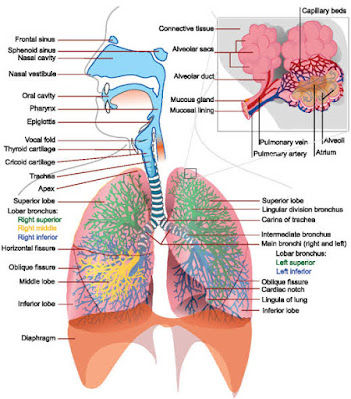Respiratory Physiology
Mechanics of Breathing
The processes of inspiration (breathing in) and expiration (breathing out) are vital for providing oxygen to tissues and removing carbon dioxide from the body. Inspiration occurs via active contraction of muscles – such as the diaphragm – whereas expiration tends to be passive, unless it is forced.
Now, let's look at the physiology of ventilation – the process of inspiration and expiration, how this differs between quiet and forced breathing.
The Lungs and Breathing
The space between the outer surface of the lungs and inner thoracic wall is known as the pleural space. This is usually filled with pleural fluid, forming a seal which holds the lungs against the thoracic wall by the force of surface tension. This seal ensures that when the thoracic cavity expands or reduces, the lungs undergo expansion or reduction in size accordingly.
During breathing, the contraction and relaxation of muscles acts to change the volume of the thoracic cavity. As the thoracic cavity and lungs move together, this changes the volume of the lungs, in turn changing the pressure inside the lungs.
Boyle’s law states that the volume of gas is inversely proportional to pressure (when temperature is constant). Therefore:
- When the volume of the thoracic cavity increases – the volume of the lungs increases and the pressure within the lungs decreases.
- When the volume of the thoracic cavity decreases – the volume of the lungs decreases and the pressure within the lungs increases.
Process of Inspiration
Inspiration is the phase of ventilation in which air enters the lungs. It is initiated by contraction of the inspiratory muscles:
Diaphragm – flattens, extending the superior/inferior dimension of the thoracic cavity.
External intercostal muscles – elevates the ribs and sternum, extending the anterior/posterior dimension of the thoracic cavity.
The action of the inspiratory muscles results in an increase in the volume of the thoracic cavity. As the lungs are held against the inner thoracic wall by the pleural seal, they also undergo an increase in volume.
As per Boyle’s law, an increase in lung volume results in a decrease in the pressure within the lungs. The pressure of the environment external to the lungs is now greater than the environment within the lungs, meaning air moves into the lungs down the pressure gradient.
Process of Passive Expiration
Expiration is the phase of ventilation in which air is expelled from the lungs. It is initiated by relaxation of the inspiratory muscles:
Diaphragm – relaxes to return to its resting position, reducing the superior/inferior dimension of the thoracic cavity.
External intercostal muscles – relax to depress the ribs and sternum, reducing the anterior/posterior dimension of the thoracic cavity.
The relaxation of the inspiratory muscles results in a decrease in the volume of the thoracic cavity. The elastic recoil of the previously expanded lung tissue allows them to return to their original size.
As per Boyle’s law, a decrease in lung volume results in an increase in the pressure within the lungs. The pressure inside the lungs is now greater than in the external environment, meaning air moves out of the lungs down the pressure gradient.
Forced Breathing
Forced breathing is an active mode of breathing which utilises additional muscles to rapidly expand and contract the thoracic cavity volume. It most commonly occurs during exercise.
Active Inspiration
Active inspiration involves the contraction of the accessory muscles of breathing (in addition to those of quiet inspiration, the diaphragm and external intercostals). All of these muscles act to increase the volume of the thoracic cavity:
- Scalenes – elevates the upper ribs.
- Sternocleidomastoid – elevates the sternum.
- Pectoralis major and minor – pulls ribs outwards.
- Serratus anterior – elevates the ribs (when the scapulae are fixed).
- Latissimus dorsi – elevates the lower ribs.
- Active Expiration
- Active expiration utilises the contraction of several thoracic and abdominal muscles. These muscles act to decrease the volume of the thoracic cavity:
- Anterolateral abdominal wall – increases the intra-abdominal pressure, pushing the diaphragm further upwards into the thoracic cavity.
- Internal intercostal – depresses the ribs.
- Innermost intercostal – depresses the ribs.






Comments
Post a Comment
Was the article helpful? Say something